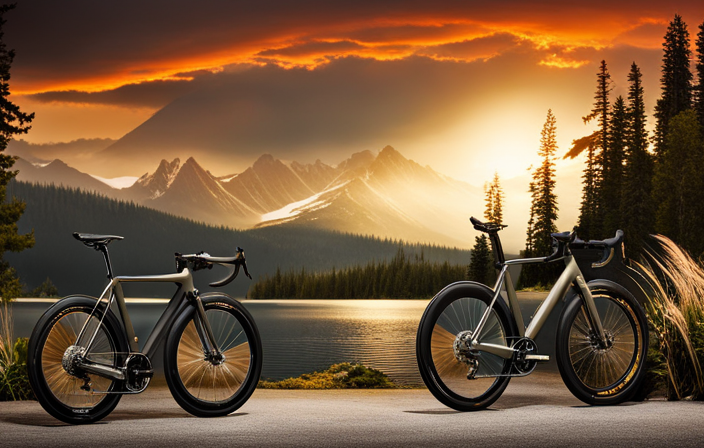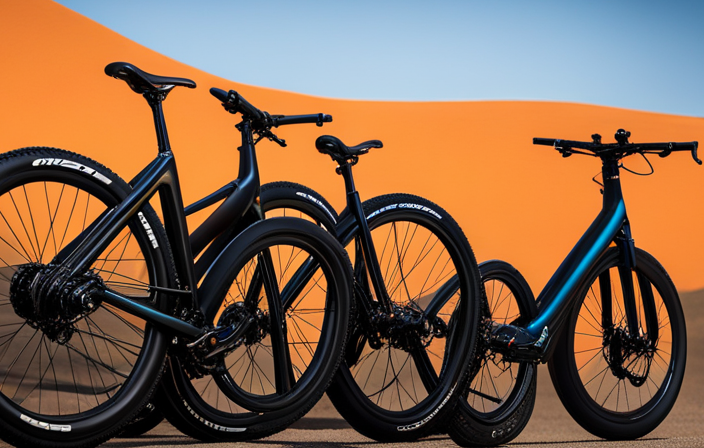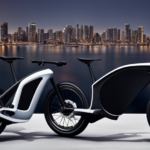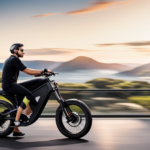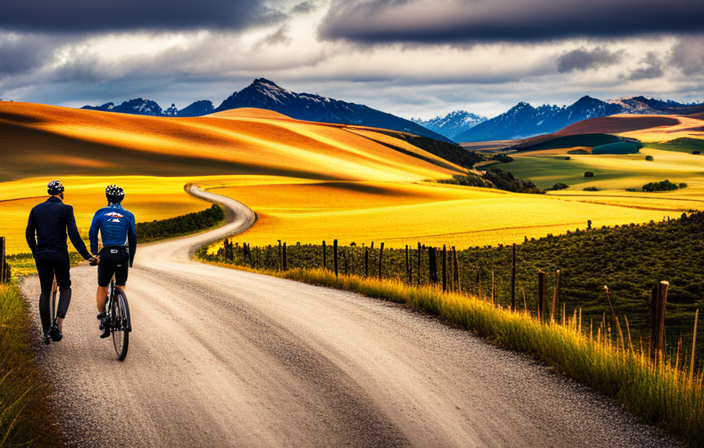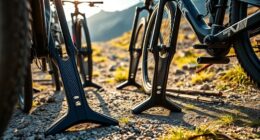The never-ending search for **speed** on a bicycle is truly thrilling. Are you ready to discover the secrets to **fast** cycling? Keep reading to uncover some exciting tips and tricks that will have you flying down the road in no time! Get ready to embrace the need for **velocity** on your bike journey!
As a cyclist, I’ve often wondered just how much faster a road bike can be compared to its gravel counterpart. Will it make me feel like a superhero effortlessly gliding through the wind? Or will it only shave off mere seconds from my commute?
In this article, we’ll dive into the nitty-gritty details of frame geometry, tire width, aerodynamics, and more to finally answer the burning question: How much faster is a road bike than a gravel bike?
Let’s find out.
Key Takeaways
- Road bikes are designed for maximum efficiency on paved surfaces, while gravel bikes are designed for off-road riding with features like front suspension and forgiving frame design.
- Road bike tires are narrower, lighter, and have lower rolling resistance, while gravel bike tires are wider, have thicker casings for puncture resistance, and provide better grip on loose surfaces.
- Road bikes are lighter than gravel bikes, allowing for quicker acceleration, higher speeds, and less effort required for uphill climbs.
- Gearing optimization is important for efficient power transfer, and road bikes and gravel bikes have different gear ratios for their respective purposes, affecting the speed and performance difference between the two.
The Basics: Understanding Road Bikes and Gravel Bikes
If you want to understand the basics of road bikes and gravel bikes, you’ll need to know their key differences.
One major distinction lies in the frame material used. Road bikes typically have frames made of lightweight materials like carbon fiber or aluminum, which allows for greater speed and maneuverability on smooth pavement. On the other hand, gravel bikes often have frames made of steel or titanium, providing durability and stability needed for off-road riding.
Another significant difference between road bikes and gravel bikes is the suspension system. Road bikes usually do not have any suspension, as they are designed for maximum efficiency on paved surfaces. This lack of suspension helps to transfer power from the rider’s legs directly to the wheels, resulting in faster speeds. In contrast, gravel bikes often feature some form of front suspension or a more forgiving frame design that can absorb bumps and vibrations encountered on rough terrain.
Understanding these fundamental distinctions lays a solid foundation for comprehending how road bikes differ from gravel bikes. As we delve deeper into this discussion, we will explore frame and geometry differences that further contribute to variations in performance between these two types of bicycles.
Frame and Geometry Differences
When it comes to frame and geometry differences, you’ll notice a significant contrast between a road bike and a gravel bike. Let’s start with the frame materials. Road bikes are typically made from lightweight materials such as carbon fiber or aluminum, which allows for better efficiency and speed on smooth pavement. On the other hand, gravel bikes often feature steel or titanium frames that offer durability and stability on rough terrain.
Another key difference is the suspension system. Road bikes usually have no suspension at all, relying solely on the flexibility of the tires to absorb vibrations. This makes them ideal for fast-paced rides on smooth roads. In contrast, gravel bikes often come equipped with front fork suspension or even full-suspension systems to provide a smoother ride over uneven surfaces.
These frame and geometry variances directly affect how each type of bike performs in terms of speed and comfort. The lightweight construction of road bikes allows for faster acceleration and higher speeds on paved roads, while the more robust build of gravel bikes offers stability and control when tackling off-road trails.
Now let’s transition into discussing tire width and rolling resistance in order to further understand how these factors contribute to the performance disparity between road bikes and gravel bikes without skipping a beat.
Tire Width and Rolling Resistance
To understand the performance disparity between road bikes and gravel bikes, it is important to consider how tire width and rolling resistance play a role.
Tire Pressure and Traction:
The narrower tires of road bikes allow for higher tire pressures, resulting in reduced contact area with the ground. This translates to less traction on loose surfaces like gravel. Gravel bikes, on the other hand, have wider tires that can be run at lower pressures. This increases the contact area, providing better grip and control when riding off-road.
Tire Construction and Puncture Resistance:
Road bike tires are typically thinner and lighter to optimize speed. However, this means they are more susceptible to punctures from sharp objects or rough terrains. Gravel bike tires, on the other hand, are designed with thicker casings and reinforced sidewalls to withstand the demands of unpredictable off-road conditions. They offer greater puncture resistance without compromising too much on speed.
Rolling Resistance:
Due to their narrow profile and smooth tread patterns, road bike tires have lower rolling resistance compared to their wider counterparts. Gravel bike tires usually feature a more aggressive tread pattern for enhanced traction on uneven surfaces. While this increases rolling resistance slightly, it provides better control when navigating through loose gravel or dirt.
Considering these factors related to tire width and rolling resistance helps explain why road bikes excel in speed while gravel bikes prioritize stability off-road. Moving forward into the next section about aerodynamics and speed… [transition sentence].
Aerodynamics and Speed
Aerodynamics can greatly impact the speed of a cyclist. When it comes to performance, reducing wind resistance is key. Road bikes are designed with aerodynamics in mind, allowing cyclists to cut through the air more efficiently compared to gravel bikes. This improved aerodynamic profile translates into higher speeds and better endurance.
One of the main factors that contribute to road bikes’ superior aerodynamics is their drop handlebars. This design allows riders to adopt a more streamlined position, minimizing frontal area and reducing drag. Additionally, road bike frames often feature sleeker tubing shapes and integrated components that further enhance their aerodynamic performance.
The difference in speed between road bikes and gravel bikes becomes even more noticeable when riding at high velocities. At these speeds, the benefits of reduced wind resistance become increasingly significant, allowing road bike riders to maintain faster average speeds over longer distances.
In conclusion, aerodynamics play a crucial role in determining the speed and endurance of a cyclist. Road bikes excel in this aspect due to their specialized design features that reduce drag and improve efficiency.
Transitioning into the next section about weight and efficiency, it’s important to consider how these factors also contribute to overall cycling performance without compromising durability or comfort.
Weight and Efficiency
Another important factor that affects a cyclist’s performance is the weight of their bike and how efficiently it can transfer power. When it comes to bike weight, road bikes are typically lighter than gravel bikes. This reduced weight allows road bikes to accelerate more quickly and maintain higher speeds on flat terrain. Additionally, a lighter bike requires less effort to pedal uphill, resulting in improved climbing ability.
In terms of pedal efficiency, road bikes also have an advantage over gravel bikes. With their narrower tires and stiffer frames, road bikes offer less rolling resistance, allowing cyclists to transfer more power from their legs to the pedals with each stroke. This increased efficiency translates into faster speeds and less fatigue over long distances.
To summarize, here are four key points regarding the relationship between bike weight and pedal efficiency:
- Lighter road bikes accelerate faster and maintain higher speeds on flat terrain.
- Lighter bikes require less effort for uphill climbs.
- Road bikes have narrower tires and stiffer frames, reducing rolling resistance.
- Increased pedal efficiency leads to faster speeds and improved endurance.
As we transition into discussing gearing and power transfer in the next section…
Gearing and Power Transfer
Transitioning from the previous subtopic of weight and efficiency, let’s now delve into the importance of gearing optimization and power transfer efficiency in road bikes and gravel bikes. These factors play a crucial role in determining how much faster a road bike can be compared to a gravel bike.
Gearing optimization refers to finding the optimal combination of gear ratios that allows for efficient pedaling at different speeds and terrains. Road bikes typically have higher gear ratios, which enable riders to achieve higher speeds on flat roads or descents. On the other hand, gravel bikes are equipped with lower gear ratios to tackle rougher surfaces and steeper inclines. This difference in gearing allows road bikes to maintain faster speeds on smoother surfaces.
Power transfer efficiency is another key aspect that influences speed. Road bikes are designed with stiffer frames, more aerodynamic positions, and narrower tires, all contributing to better power transfer from the rider’s legs to the pedals. Gravel bikes prioritize comfort over raw power transfer, featuring more compliant frames and wider tires that absorb vibrations and uneven terrain.
To visually illustrate these differences between road bikes and gravel bikes, refer to the table below:
| Gearing Optimization | Power Transfer Efficiency | |
|---|---|---|
| Road Bike | Higher gear ratios | Stiffer frame |
| Gravel Bike | Lower gear ratios | Compliant frame |
Considering these aspects of gearing optimization and power transfer efficiency provides valuable insight into understanding why road bikes have an advantage when it comes to speed on smooth surfaces. Now let’s explore how handling and stability contribute further to the performance disparity between these two bike types without skipping a beat.
Handling and Stability
When it comes to handling and stability, significant differences exist between road bikes and gravel bikes. Road bikes are designed for speed and efficiency on smooth pavement, while gravel bikes are built to handle rougher terrain. This difference in design translates into a variance in bike stability.
Road bikes have a more aggressive geometry, with shorter wheelbases and steeper head tube angles. This setup allows for quick and precise handling, making them ideal for tight turns and fast cornering. On the other hand, gravel bikes have longer wheelbases and slacker head tube angles, providing more stability when riding over uneven surfaces.
The wider tires on gravel bikes also contribute to their enhanced stability. These tires provide better traction and absorb more shocks from bumps in the road or trail. Additionally, the lower tire pressure used on gravel bikes further enhances their cornering ability.
In contrast, road bikes excel at high-speed cornering due to their narrower tires and higher tire pressures. The combination of these factors results in a more nimble ride that allows riders to lean into corners with confidence.
Moving forward into the section about riding position and comfort…
Riding Position and Comfort
The riding position on a gravel bike is generally more upright and relaxed, providing increased comfort during long rides. This is due to the design of the frame and handlebars, which allow for a more comfortable body posture. The higher handlebar position helps to take pressure off the wrists and shoulders, reducing fatigue and strain on these areas. Additionally, the shorter reach to the handlebars allows for a more natural arm extension, further enhancing comfort.
In contrast, road bikes typically have a more aggressive riding position with lower handlebars and a longer reach. This position is optimized for speed and aerodynamics but can be less comfortable for longer rides. The lower handlebars put more weight on the rider’s hands and arms, leading to increased fatigue and discomfort.
When it comes to riding position and comfort, gravel bikes are designed with endurance in mind. They prioritize rider comfort over aerodynamic efficiency, making them ideal for longer rides or rougher terrain where stability is important.
Transitioning into the next section about terrain and surface considerations: Speaking of rougher terrain…
Terrain and Surface Considerations
Gravel bikes are versatile and can handle a variety of terrains, such as gravel roads, dirt trails, and even some light off-road sections. When it comes to terrain and surface considerations, the type of bike you choose can greatly impact your riding experience.
Gravel bikes are designed with wider tires that provide better traction on loose surfaces like gravel or dirt. The increased tire grip allows for more stability and control when navigating through rough terrain. Additionally, gravel bikes often feature lower gearing options, which make climbing steep or uneven surfaces easier.
The surface conditions you encounter while riding can also play a significant role in determining whether a road bike or a gravel bike is more suitable. Gravel roads tend to have uneven surfaces with loose stones, requiring the added stability that a gravel bike provides. On the other hand, smooth paved roads favor the speed and efficiency of a road bike.
Transitioning into the next section about the impact of riding style and skill level, it’s important to consider how these factors can further influence your choice of bike.
The Impact of Riding Style and Skill Level
Riding style and skill level greatly affect the choice of bike. When it comes to comparing a road bike and a gravel bike, these factors become even more important. The type of terrain you ride on and your preferred riding technique play a significant role in determining which bike is better suited for you.
In terms of riding technique, road bikes are designed for speed and efficiency on smooth pavement. They have a more aggressive riding position with dropped handlebars, allowing for better aerodynamics. On the other hand, gravel bikes are built to handle rougher terrains with wider tires and more relaxed geometry, providing stability and comfort during off-road adventures.
Moreover, equipment upgrades can also impact your overall performance on either bike. Road bikes often come with lightweight frames, aerodynamic wheels, and narrower tires that minimize rolling resistance. These features allow for faster speeds on flat roads or uphill climbs. Gravel bikes, however, prioritize durability over speed. They usually have wider tires with more grip for enhanced traction on loose surfaces.
Taking into consideration both riding technique and equipment upgrades will help you make an informed decision about which bike suits your needs best. Now let’s delve into another factor that affects cycling speed: wind resistance and drafting techniques…
Wind Resistance and Drafting
When it comes to cycling, wind resistance and drafting techniques can have a significant impact on your speed. Wind tunnel testing has shown that the shape of a bike and its components play a crucial role in reducing drag. Road bikes are designed with aerodynamics in mind, featuring sleek frames, narrow tires, and drop handlebars that allow the rider to maintain a more streamlined position. On the other hand, gravel bikes prioritize stability and versatility over aerodynamics due to their wider tires and more upright riding position.
Drafting is another technique that can enhance speed by reducing wind resistance. By closely following another cyclist or forming a paceline, you can take advantage of the reduced air pressure created by the lead rider. This allows you to exert less effort while maintaining higher speeds.
To summarize:
- Road bikes are optimized for aerodynamics with sleek frames and narrow tires.
- Gravel bikes prioritize stability and versatility over aerodynamics.
- Wind tunnel testing has proven the importance of bike design in reducing drag.
- Drafting techniques such as forming pacelines can significantly reduce wind resistance.
Understanding how wind resistance affects your cycling performance and utilizing drafting techniques can make a noticeable difference in your speed.
Moving forward into the section about training and conditioning, it’s important to consider these factors alongside physical preparation to maximize your overall performance on both road bikes and gravel bikes.
Training and Conditioning
To improve your cycling performance, it’s essential to focus on training and conditioning. One important aspect of this is ensuring that your bike fits you properly. A well-fitted bike can make a significant difference in your comfort and efficiency on the road. It allows for proper alignment of your body, reducing the risk of injuries and maximizing power transfer to the pedals.
Interval training is another key component of training and conditioning for cyclists. This involves alternating between periods of high-intensity effort and recovery. By pushing yourself during intense intervals, you can improve your cardiovascular fitness, increase your lactate threshold, and enhance your overall endurance on the bike.
Incorporating interval training into your cycling routine can be done through various methods such as hill repeats, sprints, or timed efforts. These workouts help simulate race conditions and prepare you for the demands of riding at higher speeds.
As you transition into the subsequent section about ‘the role of equipment and accessories,’ it’s important to note that while training and conditioning are crucial for improving performance, having the right equipment is also essential in optimizing your capabilities on a bike.
The Role of Equipment and Accessories
Having the right equipment and accessories is crucial for optimizing your capabilities on a bike. When it comes to road biking versus gravel biking, the role of technology and bike fit plays a significant role in determining performance.
Road bikes are designed for speed and efficiency on smooth pavement. They are equipped with lightweight frames, narrow tires, and aerodynamic features that reduce wind resistance. This combination allows road bikes to reach higher speeds with less effort compared to gravel bikes. On the other hand, gravel bikes are built for versatility and stability on rough terrain. They have wider tires with more traction, stronger frames to withstand impact, and relaxed geometry for comfort during long rides.
Bike fit also plays a crucial role in maximizing performance. A properly fitted bike ensures optimal power transfer through efficient pedal strokes while minimizing discomfort or risk of injury. Road bikes are typically more aggressive in their riding position, which can enhance aerodynamics but may require greater flexibility and core strength.
To emphasize the differences between road bikes and gravel bikes, consider the following table:
| Road Bike | Gravel Bike | |
|---|---|---|
| Speed | High | Moderate |
| Terrain | Smooth pavement | Rough surfaces |
| Tire Width | Narrow | Wide |
Understanding the role of technology and considering how bike fit impacts performance is essential when choosing between a road bike or a gravel bike. It ultimately determines your real-world performance and race results without compromising your comfort or efficiency.
Real-World Performance and Race Results
If you want to optimize your real-world performance and improve your race results, it’s crucial to consider the differences between road bikes and gravel bikes. When it comes to race strategies, the type of bike you choose can have a significant impact on your overall performance.
Road bikes are designed for speed and efficiency on smooth pavement, making them ideal for road races where every second counts. On the other hand, gravel bikes are built to handle rougher terrains and provide more stability and control when riding off-road.
When comparing real-world performance between road bikes and gravel bikes, it’s clear that road bikes have the edge in terms of speed. The aerodynamic design, lightweight frame, and narrow tires of a road bike allow for faster acceleration and higher top speeds compared to a gravel bike. This advantage becomes even more pronounced during sprint finishes or long stretches of flat roads.
However, it’s important to note that equipment upgrades can help bridge the gap between the two types of bikes. By investing in lighter components such as carbon fiber wheels or upgrading to a more aerodynamic frame design, you can improve the overall performance of a gravel bike.
In conclusion, understanding the differences in real-world performance between road bikes and gravel bikes is essential for race success. While road bikes offer superior speed on smooth surfaces, equipment upgrades can enhance the capabilities of a gravel bike. Ultimately, choosing the right bike for your riding goals involves considering both race strategies and potential equipment enhancements.
Choosing the Right Bike for Your Riding Goals
When determining your riding goals, it’s important to consider which bike is best suited for your needs. Choosing the right bike involves considering factors such as bike fit, durability, and maintenance. Here are four key points to keep in mind:
-
Bike Fit: Ensuring that your bike fits you properly is crucial for comfort and performance. A road bike typically has a more aggressive riding position with a lower handlebar height and longer reach, while a gravel bike offers a more upright position for better stability on rough terrain.
-
Durability: Gravel bikes are designed to withstand the demands of off-road riding, with features like wider tires and stronger frames. They are built to handle rough surfaces and can endure more abuse than road bikes. However, road bikes excel in terms of lightweight construction, making them faster on smooth pavement.
-
Maintenance: Gravel bikes often require more maintenance due to the conditions they encounter. The increased exposure to dirt, mud, and gravel can lead to quicker wear on components such as drivetrain and brakes. Road bikes generally have simpler setups that require less frequent maintenance.
Considering these factors will help you make an informed decision when choosing between a road bike or a gravel bike based on your specific riding goals. Whether you prioritize speed on paved roads or adventure on mixed terrains, selecting the right bike will enhance your overall cycling experience.
Frequently Asked Questions
Can a road bike be used on gravel roads?
Yes, a road bike can be used on gravel roads. While not specifically designed for off-road terrain, road bikes do offer some advantages on gravel. They are faster and more efficient due to their lightweight frames and narrow tires. However, road bikes have less traction and stability compared to purpose-built gravel bikes. Handling can be challenging on loose surfaces, so caution must be taken when riding a road bike on gravel roads.
Are gravel bikes slower than road bikes on pavement?
Gravel bikes, like a wise sage navigating the trials of life, possess a versatility that allows them to conquer both rugged terrain and smooth pavement.
While road bikes excel on the open road, their narrow tires limit their off-road capabilities.
On pavement, gravel bikes may not match the sheer speed of a road bike due to their heavier weight and wider tires. However, they offer advantages such as stability and comfort that make them a formidable opponent in any terrain.
How much does tire width affect the speed of a bike?
Tire width has a significant impact on the speed of a bike. A narrower tire creates less rolling resistance, resulting in higher speeds. However, it’s crucial to find the right balance with tire pressure.
Higher pressure reduces rolling resistance but can lead to decreased traction and comfort. On the other hand, lower pressure increases rolling resistance but improves traction and comfort.
Finding the optimal tire width and pressure is essential for maximizing speed and performance.
Do road bikes and gravel bikes have the same frame materials?
Road bikes and gravel bikes do not necessarily have the same frame materials. Frame durability is an important factor to consider when comparing these two types of bikes.
Road bikes typically have frames made from lightweight materials like carbon fiber or aluminum, which prioritize speed and efficiency. Gravel bikes, on the other hand, often feature more durable frames made from steel or titanium to withstand rougher terrains and provide a more comfortable ride.
Additionally, there are differences in geometry between road bikes and gravel bikes that further contribute to their distinct purposes and performance capabilities.
Can a gravel bike be as lightweight as a road bike?
Certainly! Gravel bikes can indeed be as lightweight as road bikes, but it depends on the specific model and components used.
While a gravel bike may not handle rough terrain as well as a mountain bike, it offers the versatility to tackle both paved roads and unpaved trails.
Additionally, advantages of road bikes over gravel bikes include their aerodynamics, efficiency on smooth surfaces, and ability to achieve higher speeds.
Conclusion
In conclusion, after delving into the intricacies of road bikes and gravel bikes, it is clear that each has its own strengths and purpose.
Like two sides of a coin, they represent different paths we can take in life. The road bike embodies speed and precision, urging us to chase our goals with unwavering focus.
On the other hand, the gravel bike symbolizes exploration and adventure, reminding us to embrace detours and seek new horizons.
Ultimately, the choice between these two magnificent machines depends on your personal journey and what you hope to achieve along the way.
